Gas Chambers at Auschwitz
Krema IV and Krema V
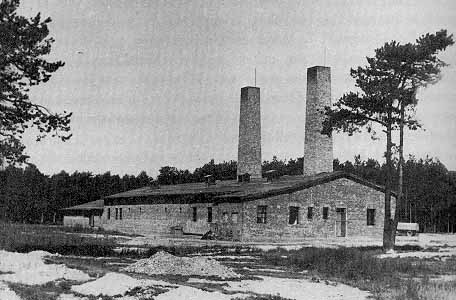 Crematorium IV at Birkenau,
as it looked in 1943
Crematorium IV at Birkenau,
as it looked in 1943
The photograph above shows the gas chamber
building known as Crematorium IV, or Krema IV, taken in the Summer
of 1943 after it became operational. This building was blown
up by Jewish inmates in a camp rebellion on October 7, 1944.
The Krema IV gas chamber, disguised as a shower room, was located
above ground in the wing of the building which is to the left
in the picture. Note that the roof line of the gas chamber is
lower than the roof of the main part of the building. Zyklon-B
poison gas pellets were thrown into the fake shower room through
windows on the outside wall of the gas chamber.
Krema IV was located just north of the
clothing warehouses which were set on fire by the Germans when
they abandoned the camp on January 18, 1945.
The photo below is a still photo from a movie made by Henryk Makarewicz, a soldier in the Polish Berlin Army, shortly after the camp was liberated. The clothing warehouses are still burning, and in the background can be seen two chimneys.
 Clothing warehouses
were still burning when Russians arrived
Photo Credit: USHMM
Clothing warehouses
were still burning when Russians arrived
Photo Credit: USHMM
Samuel Pisar, a survivor of Majdanek,
Auschwitz and Dachau, was a prisoner in the Birkenau camp when
Crematorium IV was destroyed. In an article in the Washington
Post, published on January 23, 2005, Pisar wrote that the prisoners
had set fire to buildings at Birkenau.
The following quote is from his article:
I also witnessed an extraordinary
act of heroism. The Sonderkommando -- inmates coerced to dispose
of bodies -- attacked their SS guards, threw them into the furnaces,
set fire to buildings and escaped. They were rapidly captured
and executed, but their courage boosted our morale.
Crematorium IV was across the road from
the beautiful red brick building, called "die zentrale Sauna"
which was used for disinfecting the clothing and for processing
the incoming prisoners. Crematorium IV was also near "the
little white house," where gassing operations took place,
starting in June 1942, before Crematorium IV and the Sauna were
completed.
In the movie "Schindler's List,"
women prisoners are shown exiting from the shower room in the
Sauna
building; they see the high brick chimney of Crematorium
IV, which is across the road from the Sauna. The gas chambers
in Crematorium IV and Crematorium V were above ground, although
in the movie, the prisoners are shown going down steps into an
underground undressing room.
The photo below is from the Auschwitz
Album, a book of photos taken by an SS man at Birkenau on May
26, 1944. It shows a group of Hungarian Jews waiting at the western
end of the camp; the Central Sauna, where the main shower room
was located, is across the road from where the Jews are waiting.
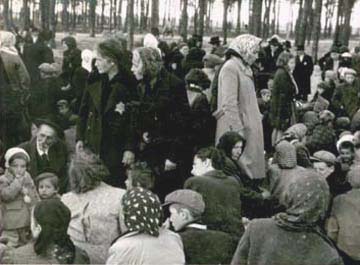 Hungarian women and
childen wait near Krema IV
Hungarian women and
childen wait near Krema IV
The Sauna was not destroyed by the Nazis
and it is the most beautiful building still standing at Birkenau.
Located at the western-most boundary of the camp, it was opened
to visitors in 2005, after being closed for over 50 years.
The Nazis practiced deception even on
the blueprints of their concentration camp buildings. The above
ground gas chambers were called "bath houses" or "shower
rooms." The building plans for Crematorium IV and Crematorium
V show shower rooms, but these rooms were actually gas chambers.
Even the Red Cross inspectors were fooled by these fake showers.
Between 29 April 1944 and 8 July 1944,
there was a total of 437,402 Hungarian Jews transported by train
to Auschwitz-Birkenau; some were immediately gassed without going
through a selection process. The next day the survivors were
told by the other prisoners that their relatives had gone "durch
den Kamin," which means "through the chimney."
This was an expresson that meant that the victims had been immediately
gassed upon arrival and then burned in the crematoria at Birkenau.
 Hungarian women who
have been selected to work at Auschwitz-Birkenau
Hungarian women who
have been selected to work at Auschwitz-Birkenau
The photo above shows women from a transport
of 3,500 Hungarian Jews which arrived at Birkenau on May 26,
1944. Note the freight cars of the transport train in the background.
In the upper right-hand corner of the
photo below is what appears to be the gate into the area where the Central Sauna
is located. Crematoria IV and V were in the same area as
the Sauna. The Jews in this photo appear to be a mixed group
with young children and some men and women who were capable of
work.
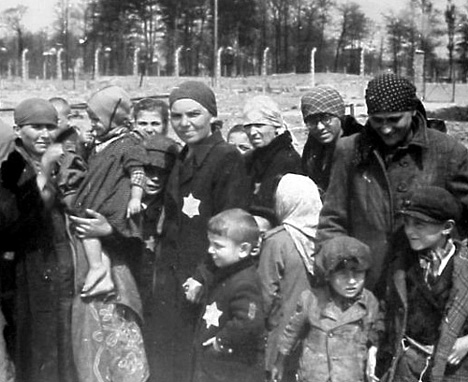 Hungarian Jews wait
at the north western end of the Birkenau camp
Hungarian Jews wait
at the north western end of the Birkenau camp
As at the Majdanek camp, two of the gas
chambers at Birkenau were located very near the clothing warehouses:
Crematorium IV and Crematorium V were immediately to the north
of the area called "Canada" where the clothing warehouses
were located. The "Canada" area at Birkenau was outside
the barbed wire enclosure for the prisoners and very near the
gas chambers, just as at Majdanek.
Directly across the road from the site
of the clothing warehouses at Birkenau is the Central
Sauna building which had a large shower room for the prisoners,
along with delousing equipment. At Majdanek, there is a real
shower room in the same building where three homicidal gas chambers
are located. The delousing chambers at Majdanek are in another
identical building, right next to the gas chamber building that
has a shower room.
According to a book from the Auschwitz
museum, when the camp was in operation, the clothing warehouses
consisted of 30 wooden horse barn buildings in 3 rows of 10;
the prisoners nicknamed the area "Canada" because of
the abundance of goods stored there. The name "Canada"
was first given to a storehouse in the main Auschwitz camp, which
was a former theater building outside the camp. This storehouse
was located behind the huge administration building which had
19 delousing chambers.
Before they abandoned the Auschwitz-Birkenau
camp, the Nazis set fire to "Canada" in the Birkenau
camp, presumably to prevent the Soviet soldiers from getting
all the stored clothing, and all that remains now is the concrete
foundations of these 30 buildings. According to a guide book
purchased at the Museum, the wooden warehouse buildings burned
for 5 days after the Nazis left on January 18, 1945.
A book entitled "The World Must
Know" from the U.S. Holocaust Museum states that "Twenty-nine
storerooms were burned. In the six that remained, the Soviets
discovered 348,820 men's suits, 836,255 women's coats, more than
seven tons of human hair, and even 13,964 carpets." The
clothing and hair is now displayed in the Auschwitz Museum in
the main camp.
The photo below shows a brick building
with clothing spilling out the door. This appears to be the Central
Sauna building at Birkenau, where the prisoners received clean,
disinfected clothing after their shower.
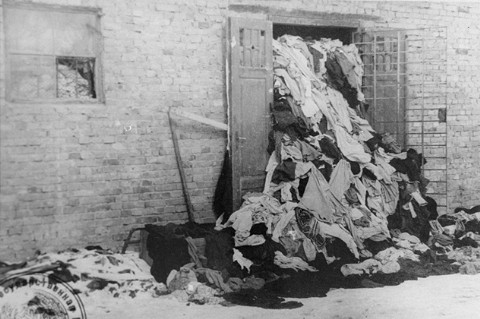 Clothing found at Auschwitz,
January 1945
Clothing found at Auschwitz,
January 1945
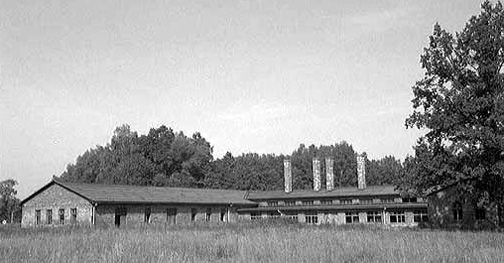 Sauna building at Birkenau
where clothing was disinfected
Sauna building at Birkenau
where clothing was disinfected
In a book entitled "An Uncertain
Hour," the author, Ted Morgan, wrote about a survivor named
Otto Abramovic who stayed behind when the Birkenau prisoners
were evacuated on January 18, 1945. "He hid out in the area
around Canada, which he knew well, and when the Russians arrived
on January 27, he was there to greet them, for he spoke some
Russian. He became their guide to scenic Canada, with its mountains
and rivers - mountains of clothing, mountains of shoes, rivers
of hair, rivers of gold teeth." Other sources claim that
the Nazis set fire to the buildings in "Canada" before
they left.
At the end of October 1944, Heinrich
Himmler had ordered gassing with Zyklon-B to be stopped, according
to a guide book sold at Auschwitz; the last "selection"
of prisoners was on October 30, 1944. This decision, according
to the guidebook, was prompted by the liberation of Majdanek
and the discovery, by soldiers of the Soviet Union, of the incriminating
evidence of 500 cans of Zyklon-B and three remaining gas chambers
with blue stains on the walls, left by the gas. His decision
was also influenced by the camp uprising when Crematorium IV
was blown up by prisoners who used dynamite that had been smuggled
in by women inmates who worked in factories outside the camp.
Crematorium V was blown up by the Nazis
on Jan. 26, 1945, only the day before the 60th Army of the First
Ukrainian Front arrived to liberate the remaining prisoners.
Crematorium V was built outside the barbed wire enclosure of
the barracks and across an interior camp road from Crematorium
IV.
The little red house, also called Bunker
1, which was used as the first gas chamber at Birkenau, was located
north of Crematorium V, close to the mass graves of the prisoners
who had died in the typhus epidemic in the camp in 1942 and the
graves of the first Jews who were gassed.
The little white house, also known as
Bunker 2, which was used as the second temporary gas chamber
was located just behind the Sauna building in the vicinity of
Crematorium IV.
This page was last updated on January
21, 2008
|